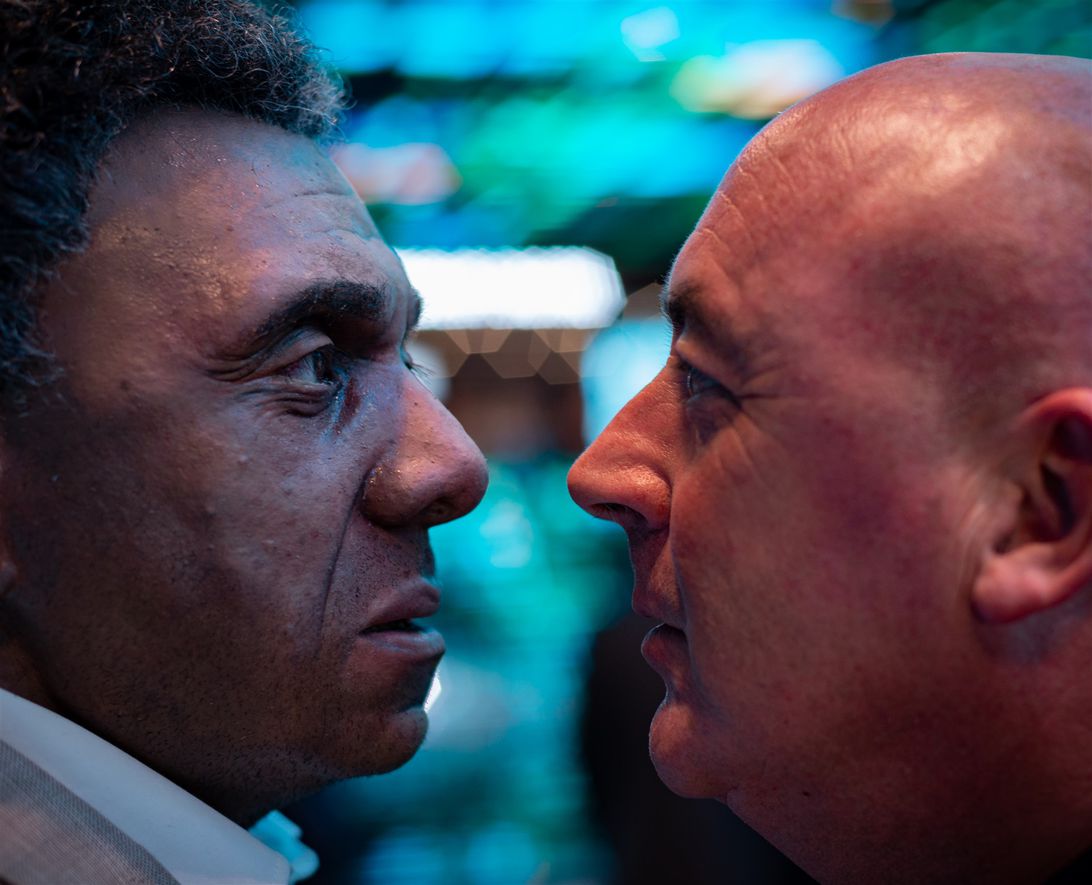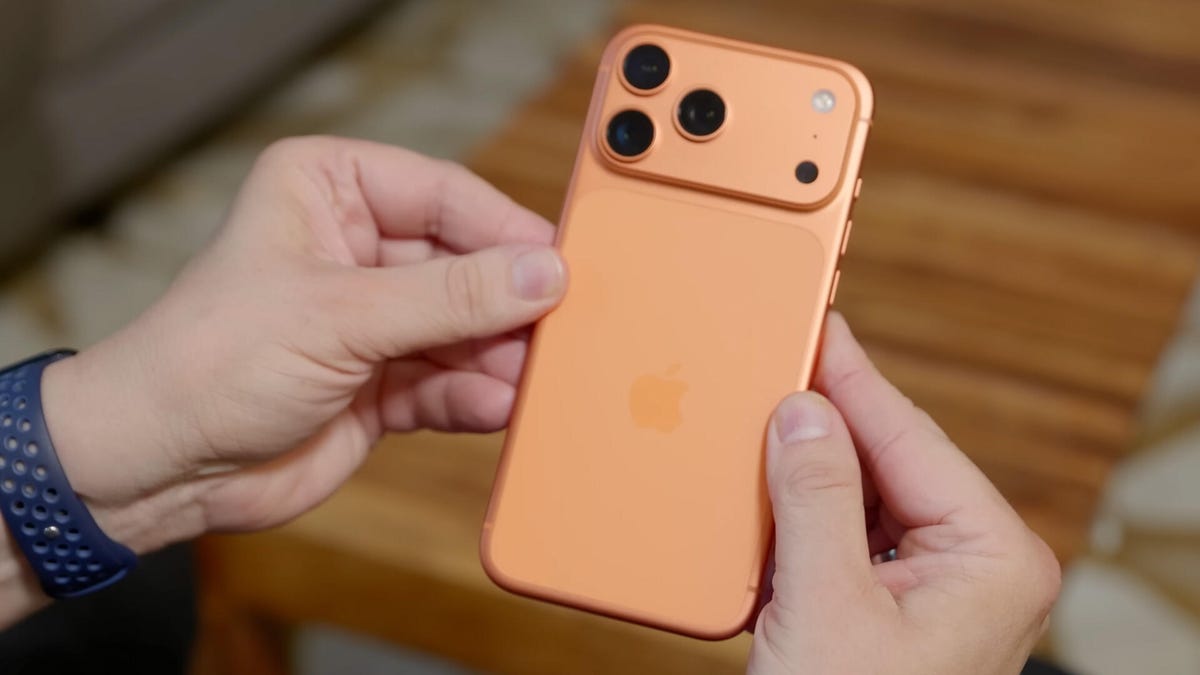Technologies
‘You have to distance yourself from it being a human’: Meeting Ameca the humanoid
Yea, though I walk through the uncanny valley, I will fear no evil.

There’s something distinctly unsettling about planning your first meeting with a robot.
At CES 2022, I had the chance to interview Ameca the robot during a one-on-one demonstration with its creators. I wanted to know if this humanoid was actually real. I wanted to see if its facial expressions were as realistic (and haunting) as they were in the videos I’d seen online. But mostly I wanted to know how the robot would respond to my questions. Should I prep a Voight-Kampff test, just to be sure?
It turns out I needn’t have worried about feeling disturbed by Ameca’s spoken responses. They were no more troublesome than what I get from Alexa. But the face Ameca made when its creator tried to poke it in the face? That will stay with me for a long time.
If you’re on the internet, you’ve probably seen Ameca. The gray-faced, humanoid robot blinked its way into the public consciousness in late 2021 when a video of its facial expressions went viral on social media. Elon Musk responded to the video with one word, «Yikes.» Chrissy Teigen retweeted it to her 13 million followers with four words: «absolutely. the fuck. not.»
But while Ameca had some people running for the hills, its creators at UK company Engineered Arts were delighted.
«We were incredibly surprised,» says Morgan Roe, Engineered Arts’ director of operations. «Overnight, it became a sensation. We got 24 million views on one Twitter post.»
Roe puts it down to Ameca’s not-quite-robot, not-quite-human appearance. Its body is all metal and plastic, its face is a deliberately genderless and nonhuman gray. It has 17 individual motors inside its head controlling its movements and expressions. But its facial features are surprisingly vivid and emotive. And it’s this combination of artificial and lifelike that Roe says speaks to our collective vision of what humanoid robots will look like in the future.
«We’ve all seen it in the movies, we’ve all seen iRobot and A.I. Artificial Intelligence,» he says. «And suddenly, that’s real.»
Roe is speaking to me via Zoom from the show floor of CES, where Ameca is being shown to crowds, in the latex flesh, for the first time. Even though I’m seeing Roe and his robot over a Zoom call, it’s hard to shake just how real Ameca looks. I find myself distracted. I’m no longer speaking to the very friendly human Englishman I’m supposed to be interviewing. My eyes are straying over to Ameca’s face to see how it’s responding to our conversation. A furrowed eyebrow ridge, the twitch of a smile. Ameca isn’t human, and yet…
This isn’t the first hauntingly humanoid robot Engineered Arts has released. For the past four years, the company has been creating a line of lifelike Mesmer robots and showing them to conferencegoers on crowded show floors.
«Each Mesmer robot is designed and built from 3D in-house scans of real people, allowing us to imitate human bone structure, skin texture and expressions convincingly,» the Engineered Arts website tells prospective clients. «Mesmer is designed to be modular, so you can remove the head with one click and no tools, and swap it for another.»
Princess Mombi, eat your heart out.
Ameca isn’t destined for the conference circuit. It doesn’t run and jump like the robots created by Boston Dynamics, and it’s not something you can preorder now as a household helper. Roe says it’ll be at least 10 years before a robot like Ameca is «walking amongst us» as a service robot. Sure, Walking Among Us sounds like the title of the documentary that’ll eventually chronicle the decline of humanity, but we’ve got another decade before we need to worry about that.
Ameca also doesn’t have Mesmer’s flesh-colored skin tones. In place of the lifelike human hair on Mesmer’s head, Ameca has a translucent plastic skull. We see the robot’s joints and parts. Ameca is still undoubtedly «other,» and that’s deliberate.
«What we found was, when you try and make it look ultra lifelike [like] our other Mesmer line, it looks a bit more sinister, because it’s right in the uncanny valley,» Roe says. «But when we created Ameca, we pulled it backwards out of the uncanny valley.»
Of course, as Roe is saying these things to me over our Zoom call, Ameca is responding. Raising its eyebrows at people walking past. Subtly moving its lips (or, more accurately, the actuators around its mouth hole) as though trying to ape the speech of its human creator.
«Because it looks less human…» says Roe, while Ameca smiles into the middle distance.
«Because it’s plastic, because it’s metal…» says Roe, Ameca glancing over at him with a vague smile.
«Because it’s of gray skin, it’s suddenly…» Roe waves his hand near Ameca’s face and the robot leans back, startled.
«Ooh, hello,» says Roe, making eye contact with the humanoid and leaning back in startled unison. He’s lost his train of thought.
«It’s suddenly, uh, less — less scary.»
I’m struck with the urge to ask the question I’ve been thinking all along. The question I’ve wanted to ask since I first saw the video of Ameca in the lab, with its engineer/programmer hunched over a laptop and another identical Ameca moving slowly in the background.
«When you’re in your offices, working late into the night on some extra lines of code, do you ever do a double take or have to check behind you, at the robot, to see if it winked at you?» I ask.
«Actually no,» says Roe. «When you’re working with it day to day, it’s suddenly, definitely a robot. And a lot of the time, you’ll see one of the engineers walking through the workshop, not with a robot, with just the head. And you have to distance yourself from it being a human. Otherwise, then it’s really sinister.»
Technologies
Nintendo’s Pokemon Legends: Z-A Is a Hit. Just Ask My Kid
Pokemon Legends: Z-A has sucked my family in, and I can’t get my Switch controller back from my son.

I’d love to tell you all about Pokemon Legends: Z-A, arriving this week, and what it’s been like to play on the Nintendo Switch 2. I can mostly do that — but for most of the past five days, it hasn’t really been me playing. What started as co-playing together quickly turned into my kid taking over completely as he got hooked. And honestly, I’d say that’s a good sign.
Nintendo makes a lot of Pokemon games, too many for me to keep track of. But Legends Z-A is the first that’s Switch 2-optimized, although you can play on original Switches, too. I can’t tell you what that’s like, though — my early review access limited me to playing Pokemon Legends: Z-A on the Switch 2 only at home. I was doubtful about how much a city-based game would truly feel like a must-have experience, but so far it’s already become one of my favorite Pokemon games ever.
I’ll let my son tell you. He’s gotten deep into the trading card game and has played most of the recent Pokemon titles over the past year, and he says this is his favorite so far. When I asked him why, he said it’s because the game completely rethinks how battles work. The quick, real-time system feels more immediate and far less sluggish than in past Pokemon games. Plus, he’s loving the story… and honestly, so am I.
A city full of surprises
My son loves the «peculiar» storyline, the fast-paced battles (which he now wants in every Pokemon game) and the constant sense of surprise while exploring Lumiose City.
All of Pokemon Legends: Z-A (at least from what I’ve seen in my 10-plus hours so far) takes place entirely within Lumiose City — a Paris-like metropolis where the CEO of a company called Quasartico Inc. is planning to rebuild everything into a new world where Pokemon and humans can better coexist. The setup reminded me of the Detective Pikachu movie during my demo a few weeks ago, and it turns out my instincts were right.
Pokemon roam in wild zones within the city, occasionally spilling into urban areas, while mysterious rogue «Mega Evolution» Pokemon have begun appearing and threatening the city’s calm. There’s clearly a deeper mystery at play, and while I’m still uncovering it, I won’t spoil anything here.
The game seems to mostly involve a journey to level up in rank from Z to A by battling various Pokemon trainers, but that’s not the whole story. There’s a group of friends you hang out with at a local hotel, along with research missions you have to carry out. Side quests are everywhere. The city, though it can feel a bit sparse at times, stretches all the way up to its rooftops, where all sorts of hidden spots are waiting to be discovered. It feels like a living maze, and one I’m still navigating.
And the city’s always changing, too. Wild zones keep multiplying, and from day to night the city’s dynamics shift. Battles take place at night, with trainers gathering in new pop-up spots each time. It’s not as lively as I’d hoped — this isn’t Grand Theft Pokemon — but the cozy, vibrant world still makes me daydream about what a real-life Universal Pokemon theme park could someday look like.
The Pokemon shine
I keep reminding myself to take extra time to discover and level up my Pokemon. At least that’s what my son’s telling me to do. He loves how many Pokemon can become Mega Evolved in this game, and how much fun the battle moves are to pull off. I’m happy he’s happy. I thought I’d get lost in the RPG aspects of the game, but I think the real-time Pokemon battles put me in a looser state of mind, more able to explore and not feel locked down into systems and rulesets. Swapping Pokemon battle moves and reassigning them to buttons is easy, too.
The stronger focus on trainer battles — and the sheer variety of Pokemon capable of mega evolving — gives the game more of that classic, Pokemon-centered energy than Pokemon Legends: Arceus ever did. I found myself more excited to see how different Pokemon looked and behaved than to uncover new realms to explore. After all, for all of Lumiose City’s secrets, you’re spending a lot more time roaming one massive location than in any other Pokemon game I can remember. Thankfully, the visual upgrades on the Switch 2 make those Pokemon look fantastic in battle.
I do want to spend more time in Lumiose City, though, and can’t help but wonder if this is a glimpse of how all Pokemon games will keep evolving. It’s hard to say, since Legends games like Z-A and Arceus have been more experimental than the rest of the series. But, like Arceus, Z-A is now one of my favorite Pokemon games on Switch. And on Switch 2, it plays smoother and feels better than any Pokemon game ever has before.
Technologies
iPhone 17 Preorders Spike and Overall Phone Sales Aren’t Slowing Down Despite Tariffs
Global smartphone shipments saw a notable increase in the third quarter of 2025. Plus, preorders for Apple’s new iPhone 17 beat out the iPhone 16.

Despite tariffs and market uncertainty, global smartphone shipments increased 2.6% in the third quarter of 2025, compared to the same time last year, according to the International Data Corporation. Additionally, preorders for the iPhone 17, which launched last month, outpaced last year’s iPhone 16.
These increased sales include premium phones like the latest iPhones and Samsung foldables, suggesting yet again that pricier phones still sell in periods of economic strain. It’s a remarkable achievement, says IDC senior research director Nabila Popal, citing shrewd financing options as the reason people keep buying these high-end phones, which cost anywhere from $800 to nearly $2,000.
«[Phone makers] have mastered the art of innovation not only in hardware and software to entice upgrades but also in removing purchase friction. They have flawlessly combined cutting-edge devices with innovative financing models and aggressive trade-in programs that make the upgrading decision a ‘no-brainer’ for consumers,» Popal said in an IDC press release.
Apple sold 58.6 million iPhones this quarter, an increase of 2.9% over the same period in 2024, with more preorders for the iPhone 17 series than its predecessor. But Samsung wasn’t far behind, with its Galaxy Z Fold 7 and Galaxy Z Flip 7 selling better than all of the company’s prior foldables. The company still reigns atop the phone market with 61.4 million phones sold, representing 19% of the market in the third quarter of this year — an increase of 6.3% from the same period last year. Meanwhile, Apple lands slightly behind Samsung with 18.2% market share this quarter.
The other phone makers trailing Apple and Samsung are, in order: Xiaomi, with 13.5% of the market; Transsion, with 9%; and Vivo with 8.9%. The remaining companies in the phones industry, from Chinese stalwarts like Oppo and Honor to Motorola and Google, make up the remaining 31.4% of the market for the quarter. All told, 322.7 million phones were sold, up from 314.6 million in the third quarter of 2024, according to IDC.
IDC’s findings for the third quarter continue the small but steady growth of phone sales over the year, including a modest 1% increase in the preceding three months — which includes the April deadline when President Donald Trump unveiled sweeping tariffs. In the second quarter, IDC cited midrange devices like Samsung’s Galaxy A36 and other phones that started incorporating AI. But even persistent tariffs haven’t slowed down people’s appetites for pricier phones in the third quarter.
Technologies
Today’s NYT Mini Crossword Answers for Tuesday, Oct. 14
Here are the answers for The New York Times Mini Crossword for Oct. 14.

Looking for the most recent Mini Crossword answer? Click here for today’s Mini Crossword hints, as well as our daily answers and hints for The New York Times Wordle, Strands, Connections and Connections: Sports Edition puzzles.
Today’s Mini Crossword has an odd vertical shape, with an extra Across clue, and only four Down clues. The clues are not terribly difficult, but one or two could be tricky. Read on if you need the answers. And if you could use some hints and guidance for daily solving, check out our Mini Crossword tips.
If you’re looking for today’s Wordle, Connections, Connections: Sports Edition and Strands answers, you can visit CNET’s NYT puzzle hints page.
Read more: Tips and Tricks for Solving The New York Times Mini Crossword
Let’s get to those Mini Crossword clues and answers.
Mini across clues and answers
1A clue: Smokes, informally
Answer: CIGS
5A clue: «Don’t have ___, man!» (Bart Simpson catchphrase)
Answer: ACOW
6A clue: What the vehicle in «lane one» of this crossword is winning?
Answer: RACE
7A clue: Pitt of Hollywood
Answer: BRAD
8A clue: «Yeah, whatever»
Answer: SURE
9A clue: Rd. crossers
Answer: STS
Mini down clues and answers
1D clue: Things to «load» before a marathon
Answer: CARBS
2D clue: Mythical figure who inspired the idiom «fly too close to the sun»
Answer: ICARUS
3D clue: Zoomer around a small track
Answer: GOCART
4D clue: Neighbors of Norwegians
Answer: SWEDES
-

 Technologies3 года ago
Technologies3 года agoTech Companies Need to Be Held Accountable for Security, Experts Say
-

 Technologies3 года ago
Technologies3 года agoBest Handheld Game Console in 2023
-

 Technologies3 года ago
Technologies3 года agoTighten Up Your VR Game With the Best Head Straps for Quest 2
-

 Technologies4 года ago
Technologies4 года agoVerum, Wickr and Threema: next generation secured messengers
-

 Technologies4 года ago
Technologies4 года agoGoogle to require vaccinations as Silicon Valley rethinks return-to-office policies
-

 Technologies4 года ago
Technologies4 года agoBlack Friday 2021: The best deals on TVs, headphones, kitchenware, and more
-

 Technologies4 года ago
Technologies4 года agoOlivia Harlan Dekker for Verum Messenger
-

 Technologies4 года ago
Technologies4 года agoiPhone 13 event: How to watch Apple’s big announcement tomorrow
